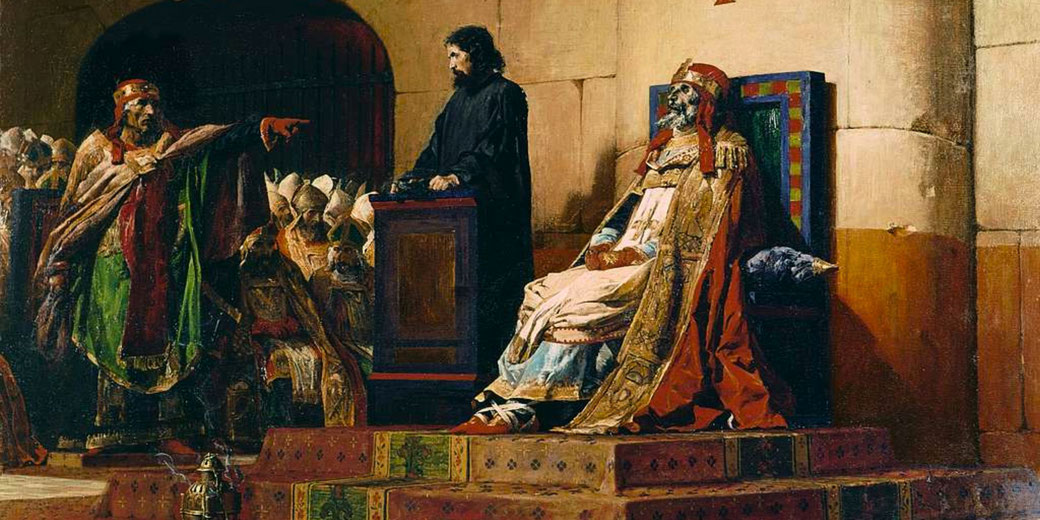The Cadaver Synod: when the Catholic Church dug up a dead pope to put his corpse on trial

The Cadaver Synod is one of the most macabre and bizarre events in the history of the Catholic Church. Picture this: a courtroom filled with bishops, priests, and deacons, all gathered around a corpse dressed in full papal regalia, propped up on a throne.
This wasn't a scene from a horror movie, but an actual trial that took place in Rome in the late 9th century.
Pope Stephen VI had ordered the exhumation of his predecessor, Pope Formosus, so that his corpse could stand trial for various charges.
Why did this happen and what was the outcome of the court case?
What was the 'Cadaver Synod'?
The Cadaver Synod, also known as the Synod Horrenda or the Synod of the Dead, was a dark chapter in the history of the Catholic Church.
The event occurred in the late 9th century, during a time when the Church was facing a power struggle between the Pope and the Holy Roman Emperor.
The Cadaver Synod was held in January of 897 CE in the Basilica of St. John Lateran in Rome.
The synod was convened by Pope Stephen VI, who had recently taken the papal throne.
His predecessor, Pope Formosus, who reigned from 891 to 896, had died nine months earlier, and Stephen VI was determined to exact revenge on his deceased rival.

Why did Stephen want revenge?
Pope Stephen VI ordered the Cadaver Synod to posthumously punish Pope Formosus for what he believed were various offenses against the Church.
In particular, Stephen VI was angry that Formosus had crowned Arnulf of Carinthia as the Holy Roman Emperor allegedly without proper consultation or approval.
Stephen VI believed that this was a violation of Church law and also that Arnulf had coerced his appointment.
Additionally, Stephen VI accused Formosus of perjury, since he had allegedly violated Church law by being a bishop in two different dioceses at the same time (although this issue had actually been resolved before Formosus became pope).
Finally, Stephen VI likely wanted to legitimize his own claim to the papacy, which was disputed by some members of the clergy who supported Formosus.
While claiming the trial was about Church law, the real motivations were political, as Stephen VI was aligned with the Spoleto faction, which had been rivals of Arnulf and enemies of Formosus.
By staging this bizarre trial and posthumously convicting Formosus of various crimes, Stephen VI sought to cement his own power and undermine the legacy of his predecessor.
The macabre trial of the corpse
The preparation for the Cadaver Synod was a highly unusual affair. Pope Stephen VI enlisted a group of his supporters, who were willing to go to any lengths to ensure that Formosus was posthumously punished.
They exhumed Formosus' corpse, which had been buried in St. Peter's Basilica, and dressed it in papal vestments.
The corpse was then brought to the courtroom, where Stephen VI presided over the trial.
The trial was a complete farce, with Stephen VI acting as prosecutor and judge, and Formosus was found guilty on all charges.
It is said that Stephen VI even had a deacon stand next to the corpse, speaking on its behalf in a macabre parody of a real trial.
During the trial, all of Formosus’ ordinations and papal decrees were declared invalid, casting doubt on the legitimacy of bishops and clergy he had appointed.
The entire trial was a bizarre and grotesque spectacle, designed to humiliate Formosus and legitimize Stephen VI's own claim to the papacy.
What happened to the body of the former pope?
After the Cadaver Synod, the body of Pope Formosus was subjected to a gruesome and macabre fate.
As punishment for his alleged crimes, Formosus' corpse was stripped of its papal vestments and had three fingers on its right hand amputated - the fingers that Formosus had used to bless people.
The body was then thrown into the Tiber River, where it was later retrieved by monks.
The desecration of Formosus' body was widely condemned by the Catholic Church and caused outrage among the clergy and the general public.
Pope Formosus' body was later redressed in sacred robes and reburied in St. Peter's Cathedral by Pope Theodore II who reigned later in 897. He also annulled the Cadaver Synod entirely.
How did the church respond?
The trial was a clear abuse of power by Pope Stephen VI, who used the trial as a means of punishing his predecessor, Pope Formosus, and consolidating his own power within the Church.
Stephen VI was imprisoned in August 897 and later strangled in his cell, a likely result of public outrage over the grotesque trial of Formosus.
The desecration of Formosus' body was an egregious violation of the dignity of the papal office and the basic principles of Christian charity and respect for the dead.
The scandal of the Cadaver Synod caused a great deal of controversy and undermined the moral authority of the Catholic Church.
However, the event also served as a catalyst for reforms within the Church, particularly in the areas of papal succession and the conduct of trials.
What do you need help with?
Download ready-to-use digital learning resources
Copyright © History Skills 2014-2025.
Contact via email
With the exception of links to external sites, some historical sources and extracts from specific publications, all content on this website is copyrighted by History Skills. This content may not be copied, republished or redistributed without written permission from the website creator. Please use the Contact page to obtain relevant permission.





